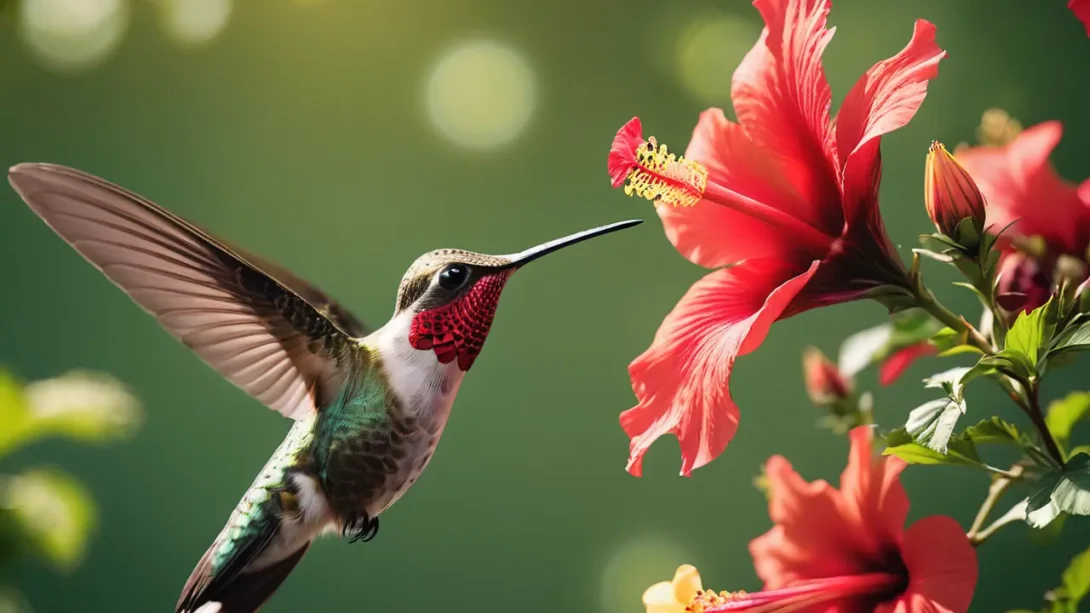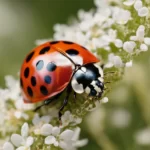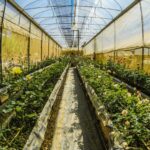Hummingbirds are fascinating creatures, known for their iridescent plumage, hovering flight, and insatiable appetite for nectar. These tiny avian marvels play a crucial role in pollination, flitting from flower to flower in search of sustenance. Among the myriad flowers that attract hummingbirds, hibiscus stands out as a particularly alluring option for both gardeners and these winged visitors.
The Fascinating World of Hummingbirds
Hummingbirds, often referred to as nature’s jewels, are among the smallest birds in the avian kingdom. With their rapid wingbeats and remarkable agility, they can hover in mid-air, darting effortlessly from one bloom to another. These pint-sized pollinators possess a voracious appetite for nectar, which serves as their primary source of energy.
One of the most captivating aspects of hummingbirds is their unique physical characteristics. With jewel-toned feathers that shimmer in the sunlight, they add a splash of vibrant color to any garden they visit. Their long, slender bills and extendable, tube-like tongues are perfectly adapted for extracting nectar from flowers with deep corollas.
Despite their diminutive size, hummingbirds have an astonishing metabolism, requiring frequent refueling to sustain their high-energy lifestyle. Nectar-rich flowers play a crucial role in meeting their dietary needs, providing the sugar-rich fuel necessary for their daily activities, including foraging, mating, and migration.
All About Hibiscus
Enter the hibiscus, a genus of flowering plants renowned for its striking blooms and tropical allure. Hibiscus plants, which belong to the mallow family (Malvaceae), encompass a diverse array of species, ranging from shrubs and trees to herbaceous perennials. Originating from regions with warm climates, such as tropical and subtropical regions, hibiscus has captured the hearts of gardeners worldwide with its showy flowers and lush foliage.
The hibiscus flower, with its intricate anatomy and vibrant hues, serves as a beacon for pollinators seeking nourishment. Characterized by large, trumpet-shaped blossoms that unfurl in a kaleidoscope of colors, hibiscus exudes an exotic charm that is irresistible to both humans and wildlife alike. Whether in shades of fiery red, sunny yellow, or deep magenta, hibiscus flowers never fail to captivate the imagination with their sheer beauty.
Why Hummingbirds Love Hibiscus
As hummingbirds zip through the garden in search of sustenance, they are drawn to certain flowers like magnets, and hibiscus ranks high on their list of favorites. The allure of hibiscus for hummingbirds lies in its abundant nectar, which serves as a vital source of energy for these tiny aerial acrobats. Hibiscus flowers produce copious amounts of sweet nectar, housed within elongated floral tubes that are accessible to the long bills of hummingbirds.
But it’s not just the abundance of nectar that makes hibiscus irresistible to hummingbirds; it’s also the unique characteristics of the flowers themselves. Hibiscus blooms exhibit a complex floral structure that caters perfectly to the feeding habits of hummingbirds. With their tubular shape and flared petals, hibiscus flowers provide a convenient landing pad for hummingbirds to perch while they probe deep into the flower to access the nectar hidden within.
The vivid colors of hibiscus blooms further enhance their appeal to hummingbirds. These birds have excellent color vision, particularly for reds, oranges, and pinks, which are often associated with a rich nectar reward. Hibiscus flowers, with their bold and vibrant hues, act as visual beacons, signaling to hummingbirds that a plentiful source of nectar awaits.
Moreover, hibiscus plants bloom prolifically throughout the growing season, ensuring a continuous supply of nectar for hungry hummingbirds. This extended flowering period makes hibiscus a reliable food source for these birds, especially during critical times such as migration or nesting season when energy demands are high.
In essence, the symbiotic relationship between hummingbirds and hibiscus is a testament to the intricate dance of nature, where each partner fulfills a vital role in the ecosystem. As hummingbirds seek sustenance from the nectar-rich flowers of hibiscus, they unwittingly facilitate the pollination of these plants, ensuring their continued propagation and survival.
How to Attract Hummingbirds with Hibiscus
Now that we understand the mutual attraction between hummingbirds and hibiscus, let’s explore how you can harness the allure of these vibrant blooms to create a hummingbird-friendly haven in your own backyard.
Plant Selection and Placement
Choose hibiscus varieties known to attract hummingbirds, such as Hibiscus syriacus or Hibiscus moscheutos, which produce large, showy flowers rich in nectar.
Plant hibiscus in locations that receive ample sunlight, as hummingbirds are more likely to visit flowers that are easily visible and accessible.
Consider placing hibiscus near other hummingbird-friendly plants to create a diverse and inviting habitat.
Garden Design and Maintenance
Incorporate hibiscus into your garden design, placing them strategically to create visual interest and focal points that draw hummingbirds in.
Ensure proper care and maintenance of hibiscus plants, including regular watering, pruning, and fertilizing, to promote healthy growth and abundant blooming.
Provide additional perching spots near hibiscus plants, such as small branches or trellises, to give hummingbirds a place to rest between feeding bouts.
Water and Feeder Placement
Install a hummingbird feeder near your hibiscus plants to supplement their natural nectar sources, especially during periods of low flower abundance.
Keep hummingbird feeders clean and filled with fresh nectar to attract and retain hummingbird visitors to your garden.
Consider incorporating a shallow water source, such as a birdbath or fountain, near your hibiscus plants to provide hummingbirds with a source of hydration and bathing.
Wildlife-Friendly Practices
Minimize the use of pesticides and herbicides in your garden to protect both hummingbirds and their preferred nectar sources like hibiscus.
Create a welcoming habitat for hummingbirds by providing shelter, such as trees, shrubs, and native grasses, where they can rest and seek refuge from predators.
Embrace a diverse planting scheme that includes a variety of native and non-native flowering plants to ensure a continuous supply of nectar throughout the seasons.
Conclusion
In the colorful tapestry of the natural world, the symbiotic relationship between hummingbirds and hibiscus is a dazzling thread that adds richness and vitality to our gardens. Through their delicate dance of pollination and nourishment, hummingbirds and hibiscus remind us of the interconnectedness of all living things and the importance of preserving biodiversity.
As you embark on your journey to attract hummingbirds with hibiscus, remember that every action you take has the power to make a difference. By creating a welcoming habitat filled with nectar-rich blooms and providing essential resources for hummingbirds, you are not only enhancing the beauty of your surroundings but also contributing to the conservation of these precious creatures.
So, whether you’re a seasoned gardener or just beginning to cultivate your green thumb, consider incorporating hibiscus into your landscape as a tribute to the enchanting allure of hummingbirds. As you watch these winged wonders flit and flutter among the vibrant blooms, you’ll find yourself captivated by the magic of nature unfolding before your eyes.
In the end, it’s not just about attracting hummingbirds to your garden—it’s about fostering a deeper connection with the natural world and embracing the joy and wonder that comes from coexisting with these magnificent creatures. So, plant your hibiscus with care, tend to your garden with love, and savor the moments spent in the company of hummingbirds, for they are fleeting treasures that enrich our lives in ways we can only begin to fathom.



